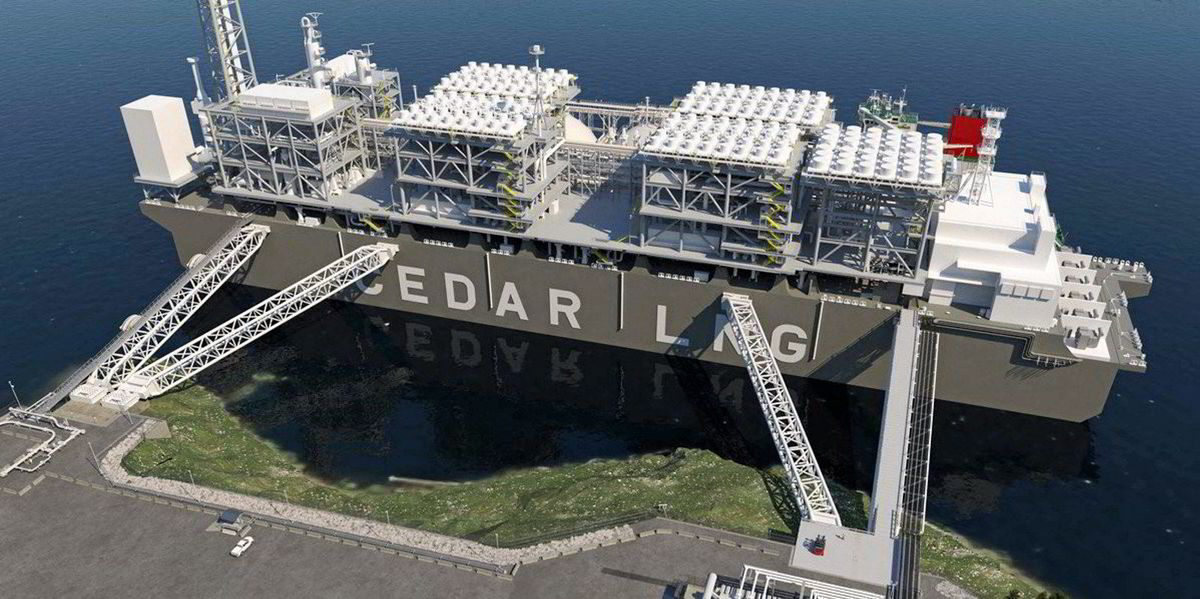[ad_1]
Our newsletter: 20 June 2024
Cedar LNG investment decision is close
Cedar LNG, a partnership of the Haisla Nation (50.1%) and Pembina Pipeline Corporation (49.9%), is on track to make a Final Investment Decision (FID) by the end of this month.
If the $4.6-billion project gets the financial go-ahead, it will bring in its floating LNG production plant in 2028, and build a connection to the Coastal GasLink pipeline for Cedar’s natural gas. It could then start up later in 2028.
Cedar will initially produce less than one-third of the global industry average for emissions from an LNG plant, and plans to achieve net-zero emissions by 2030.
It will be the first majority Indigenous-owned LNG facility in Canada — and in the world.
Crystal Smith, elected chief councillor of the Haisla Nation (and chair of our First Nations LNG Alliance) says: “The Cedar LNG project will be the largest First Nation-owned infrastructure project in Canada, creating jobs, contracting and other economic opportunities for the Haisla Nation, the community of Kitimat, neighbouring Indigenous nations, and the local region.
“Cedar LNG represents long-term growth for our region in a way that protects our land and environment, and . . . with innovative technology and reduced environmental footprint.”
Business in Vancouver reported: “Cedar LNG has an environmental certificate and long-term offtake agreements signed, and in April issued a notice to proceed to Samsung Heavy Industries and Black and Veatch on engineering, procurement and construction contracts.
“All that’s left now is for the Haisla and Pembina Pipelines to make a final investment decision.”

Ksi Lisims LNG pipeline work scheduled
The first work on a re-routed PRGT gas pipeline, to feed the Nisga’a Nation’s Ksi Lisims LNG project in northern B.C., is set to begin on August 24.
The Nisga’a announced that this early work will include building a worker camp in the Nass Valley, clearing right of way, and building roads and bridges.
The PRGT (Prince Rupert Gas Transmission) pipeline was originally proposed, in 2013, to feed gas from northeast B.C. to an LNG export facility planned by Trans Canada Corporation at Prince Rupert.
That facility plan was shelved, but the pipeline plan had been approved by government in 2014, and its permits are still alive.
The original planned route of the pipeline will have to be changed and shortened to serve Ksi Lisims. No details have yet emerged on this rerouting.
In March this year, TC Energy (the name was changed from Trans Canada in 2019) announced that it would sell PRGT to the Nisga’a Nation and Western LNG. Western LNG is a partner with the Nisga’a in the Ksi Lisims project, along with gas supplier Rockies LNG.
Ksi Lisims has said the project at Wil Milit will benefit Indigenous Nations and other communities in the region, but questions have been raised by the Gitanyow Hereditary Chiefs, the Lax Kw’alaams Band, and the Gitxsan Nation.
The Nisga’a and Gitanyow have launched a mediation process (although the Nisga’a release on that did not explicitly mention Ksi Lisims as an issue).
The Ksi Lisims plan itself is going through regulatory assessment by the B.C. Environmental Assessment Office.

LNG opportunities for Indigenous communities
Alliance CEO Karen Ogen has been speaking at events lately to support LNG development, and the benefits for Indigenous peoples.
Now Alliance board member Clifford White has also been speaking up, telling Alberta’s Canadian Energy Centre that “developing natural gas to displace coal, oil, wood, and other forms of energy with much bigger environmental impacts is a risk worth taking to help the world.”
White, a hereditary leader and former elected chief councillor of the Gitxaala Nation, also speaks of opportunities for members of his and other Indigenous communities.
“I see a real opportunity for our young people to get trained and work in monitoring, research and continuing our ancestral responsibility to ensuring the environment is protected. There are many opportunities to work, such as tugboat operators, environmental management, and as power engineers as projects begin operations.”

Indigenous clean-energy news
- Squamish company to work with First Nations in plan to bring green hydrogen production to Vancouver Island: https://ow.ly/ryXv50SinVS (Photo above)
- Hydro-Québec to buy power from Pattern Energy’s Broughton Wind project, which includes First Nation partners: https://ow.ly/M7kJ50SlivC
- Ontario’s Hydro One engages with Indigenous communities about the proposed Durham Kawartha Power Line project: https://ow.ly/Cexj50SjCP3
- Remote Manitoba First Nation works on plan to see it partially powered, and propelled, by electric vehicles: https://ow.ly/Sryk50SjCMz
- Indigenous Clean Energy issues its 2023 annual report: https://ow.ly/YSMa50SioSl
- Indigenous communities in Canada are making the clean-energy drive work for, not against, them: https://ow.ly/vb9b50SjCS8
ALSO IN THE NEWS
EVENTS
- First Nations Power Authority’s Indigenous Cleaner Energy Forum, June 25-27, Saskatoon: https://ow.ly/1jkA50Re6xu
- Forward Summit East, Sept. 25-26, Orillia ON: https://ow.ly/i65h50QnWYR
- Nation2Nation’s 8th annual forum, Oct. 8-10, Terrace BC: https://ow.ly/omzI50RAgBT
- Canadian Gas Association’s Energy Nexus and Technical Conference, Oct. 8-10, Toronto: https://ow.ly/HrKx50SbcZx
- Forward Summit West Coast, Oct. 22-23, Vancouver: https://ow.ly/4UQe50R3CY2
Know someone who might be interested in our newsletter? Please let them know that they can subscribe here, for free. You’ll also find us on Facebook, LinkedIn, and X (formerly called Twitter).
[ad_2]
Source link
